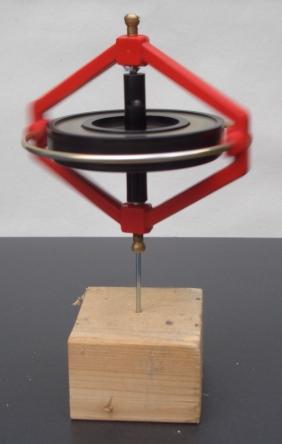
Angular momentum
In physics, angular momentum (sometimes called moment of momentum or rotational momentum) is the rotational analog of linear momentum. It is an important physical quantity because it is a conserved quantity – the total angular momentum of a closed system remains constant. Angular momentum has both a direction and a magnitude, and both are conserved. Bicycles and motorcycles, flying discs,[1] rifled bullets, and gyroscopes owe their useful properties to conservation of angular momentum. Conservation of angular momentum is also why hurricanes[2] form spirals and neutron stars have high rotational rates. In general, conservation limits the possible motion of a system, but it does not uniquely determine it.
Angular momentum
L
kg⋅m2⋅s−1
yes
L = Iω = r × p
The three-dimensional angular momentum for a point particle is classically represented as a pseudovector r × p, the cross product of the particle's position vector r (relative to some origin) and its momentum vector; the latter is p = mv in Newtonian mechanics. Unlike linear momentum, angular momentum depends on where this origin is chosen, since the particle's position is measured from it.
Angular momentum is an extensive quantity; that is, the total angular momentum of any composite system is the sum of the angular momenta of its constituent parts. For a continuous rigid body or a fluid, the total angular momentum is the volume integral of angular momentum density (angular momentum per unit volume in the limit as volume shrinks to zero) over the entire body.
Similar to conservation of linear momentum, where it is conserved if there is no external force, angular momentum is conserved if there is no external torque. Torque can be defined as the rate of change of angular momentum, analogous to force. The net external torque on any system is always equal to the total torque on the system; in other words, the sum of all internal torques of any system is always 0 (this is the rotational analogue of Newton's third law of motion). Therefore, for a closed system (where there is no net external torque), the total torque on the system must be 0, which means that the total angular momentum of the system is constant.
The change in angular momentum for a particular interaction is called angular impulse, sometimes twirl.[3] Angular impulse is the angular analog of (linear) impulse.
Examples[edit]
The trivial case of the angular momentum of a body in an orbit is given by
where is the mass of the orbiting object, is the orbit's frequency and is the orbit's radius.
The angular momentum of a uniform rigid sphere rotating around its axis, instead, is given by
where is the sphere's mass, is the frequency of rotation and is the sphere's radius.
Thus, for example, the orbital angular momentum of the Earth with respect to the Sun is about 2.66 × 1040 kg⋅m2⋅s−1, while its rotational angular momentum is about 7.05 × 1033 kg⋅m2⋅s−1.
In the case of a uniform rigid sphere rotating around its axis, if, instead of its mass, its density is known, the angular momentum is given by
where is the sphere's density, is the frequency of rotation and is the sphere's radius.
In the simplest case of a spinning disk, the angular momentum is given by[4]
where is the disk's mass, is the frequency of rotation and is the disk's radius.
If instead the disk rotates about its diameter (e.g. coin toss), its angular momentum is given by[4]
Angular momentum in optics[edit]
In classical Maxwell electrodynamics the Poynting vector
is a linear momentum density of electromagnetic field.[44]
The angular momentum density vector is given by a vector product
as in classical mechanics:[45]
The above identities are valid locally, i.e. in each space point in a given moment .
Angular momentum in nature and the cosmos[edit]
Tropical cyclones and other related weather phenomena involve conservation of angular momentum in order to explain the dynamics. Winds revolve slowly around low pressure systems, mainly due to the coriolis effect. If the low pressure intensifies and the slowly circulating air is drawn toward the center, the molecules must speed up in order to conserve angular momentum. By the time they reach the center, the speeds become destructive.[2]
Johannes Kepler determined the laws of planetary motion without knowledge of conservation of momentum. However, not long after his discovery their derivation was determined from conservation of angular momentum. Planets move more slowly the further they are out in their elliptical orbits, which is explained intuitively by the fact that orbital angular momentum is proportional to the radius of the orbit. Since the mass does not change and the angular momentum is conserved, the velocity drops.
Tidal acceleration is an effect of the tidal forces between an orbiting natural satellite (e.g. the Moon) and the primary planet that it orbits (e.g. Earth). The gravitational torque between the Moon and the tidal bulge of Earth causes the Moon to be constantly promoted to a slightly higher orbit (~3.8 cm per year) and Earth to be decelerated (by −25.858 ± 0.003″/cy²) in its rotation (the length of the day increases by ~1.7 ms per century, +2.3 ms from tidal effect and −0.6 ms from post-glacial rebound). The Earth loses angular momentum which is transferred to the Moon such that the overall angular momentum is conserved.






























